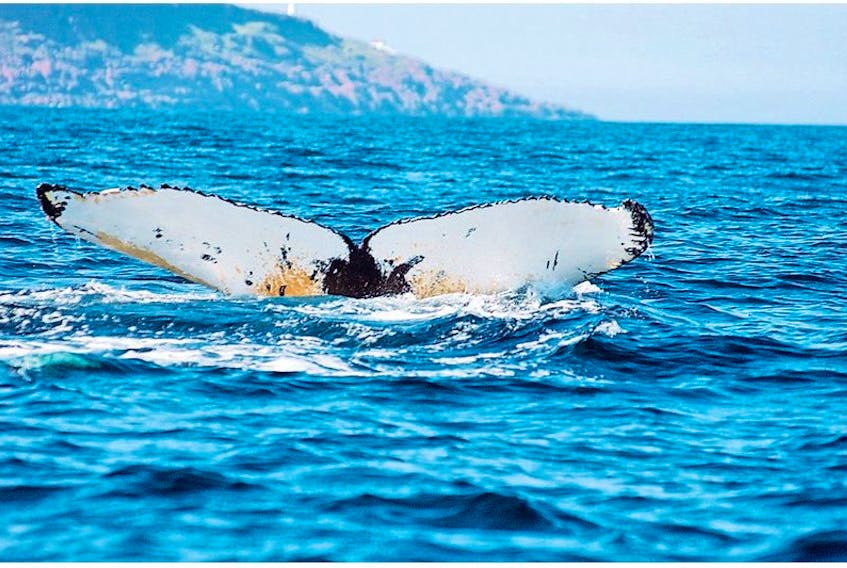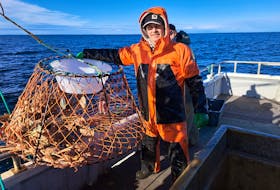In the middle of the night on July 24, 2017, far to the east of Newfoundland, two survey vessels passed in thick fog. They were over 200 miles from land, but on two very different missions to document the Flemish Pass, a deep channel dividing the Grand Banks from the Flemish Cap.
Although beyond Canada’s Exclusive Economic Zone (EEZ), this area is considered the “high seas.” Canada is working to extend our EEZ here, promising a new frontier for oil and gas development, and a new environmental reality for whales and wildlife that live there.
The impacts of these activities on the ocean environment have little profile, despite the documented effects of spills and seismic noise on ocean life.
Heading north was Balaena, a 16-tonne sailing boat, with a crew of five from Dalhousie University. Balaena was using hydrophones — underwater microphones — to conduct the first dedicated survey for whales in the Flemish Pass area, recording the sounds of rare beaked whales.
Heading south was Ramforth Sterling, a 13,000-tonne seismic survey vessel. Under the auspices of the Canada-Newfoundland Offshore Petroleum Board, it was surveying for oil and gas. Over eight kilometres of hydrophone cables recorded the echoes from Ramforth’s powerful air-gun pulses, telling of deep rock formations and potential oil reserves.
Tens of kilometres apart, Balaena’s hydrophones began picking up Ramforth’s seismic pulses, rumbling bands of growing red energy obliterating all other low frequency sounds on the visual display. As the vessels approached, Ramforth’s “guard boat” radioed Balaena and requested it make way. Survey vessels normally have right of way, but both were surveying, so Balaena declined. Ramforth responded that its survey was large in scale — kilometres of hydrophones and so on — and, by implication, large in significance. The guard boat helpfully pointed out that as Balaena was under sail, the Balaena had right of way. Finally, Ramforth agreed to slow down, and the vessels passed safely, but Balaena’s recordings were overwhelmed by seismic pulses.
The asymmetry of the encounter between Ramforth Sterling and Balaena is emblematic of our attitudes to that vast ocean area east of Newfoundland. Although not part of our national waters, Canadian and foreign industries are keen to exploit it economically. The Government of Newfoundland and Labrador is actively encouraging drilling of 100 new exploratory wells over the next 10 years in the offshore waters east of Newfoundland. A CBC headline in 2017 suggested that the seismic program off Newfoundland was the “Largest three-dimensional seismic program in the world.”
The impacts of these activities on the ocean environment have little profile, despite the documented effects of spills and seismic noise on ocean life. Drilling operations east of Newfoundland spilled 250,000 litres of oil last month. The ongoing disturbance to the soundscape from seismic air gun explosions can cause long-term stress, injury or death to animals ranging from crabs to whales.
For centuries, these waters sustained one of the world’s largest fisheries. But we still know very little of the underlying biology. Government surveys for marine mammals stop at the 200-mile limit. The Hudson, Canada’s primary offshore research vessel, is 55 years old, an antique beside the Ramforth. But, on a cruise to the Sackville Spur at the northern end of the Flemish Pass, Hudson discovered rare deep-water corals. The Sackville Spur is also where Balaena found the highest density of whales, including groups of endangered northern bottlenose whales. In this marine oasis, oil and gas interests are at odds with a fragile deepwater ecology.
Canada, by encouraging and regulating oil and gas activities, is projecting its sovereignty far beyond the 200-mile limit. Surely we should have even greater concern for the environment that will be impacted? Money and political capital are being poured into destructive developments, but we hardly know what will be affected.
Development east of the 200-mile limit should be paused until the biology of the region has been properly surveyed and we have a coherent management plan, including marine protected areas in special places like the Sackville Spur. Let us slow down and get to know these places a little before we make irreversible decisions that may disrupt them forever.
Hal Whitehead
Herring Cove, N.S.
Laura Feyrer, Halifax
Editor’s note: Hal Whitehead is a professor and Laura Feyrer is a PhD candidate with the biology department at Dalhousie University, and they were on board Balaena on July 24, 2017.









